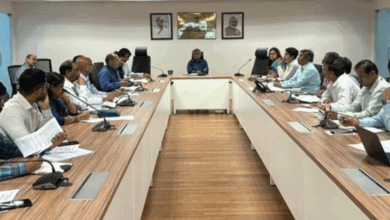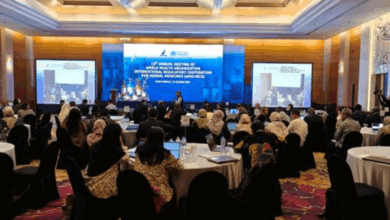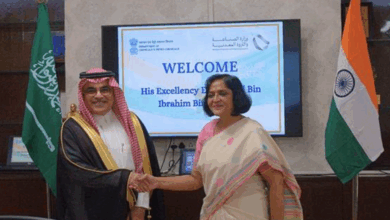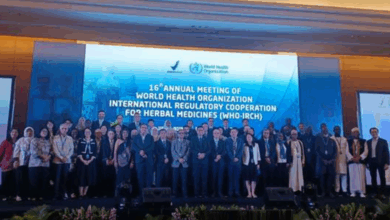Shri Dharmendra Pradhan and Smt Annapurna Devi jointly launch the “Guidelines for Co-location of Anganwadi Centres with Schools”
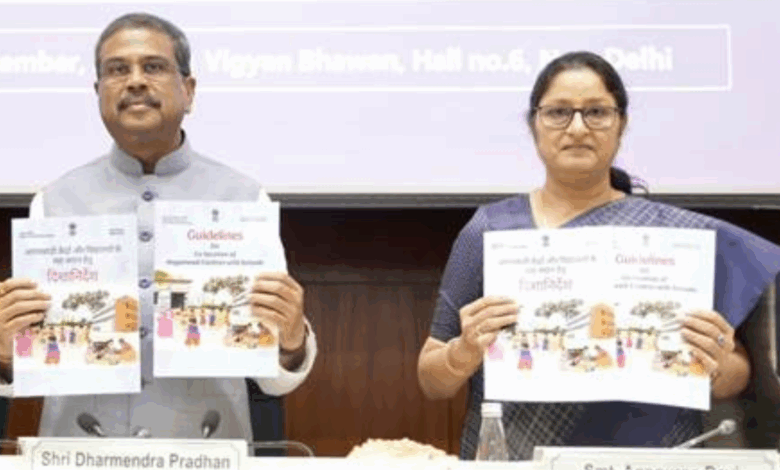
Shri Dharmendra Pradhan, Union Minister of Education and Smt. Annpurna Devi, Union Minister of Women & Child Development, jointly launched the Guidelines for Co-location of Anganwadi Centres with Schools on 3rd September 2025 at Vigyan Bhawan, New Delhi.
Speaking on the occasion, Shri Dharmendra Pradhan said that this initiative marks a significant milestone towards realising Prime Minister Shri Narendra Modi’s vision of ‘Viksit Bharat’. He emphasised that the goal of a developed India will be achieved when, in the coming days, we ensure complete care for every pregnant mother, newborn child, and pre-school-going child.
The Minister proposed the creation of a dedicated learning module for Anganwadi workers (“didi”) who have not studied up to Class 12 but are keen to pursue further education.
Highlighting the role of technology, he said that today’s world has become more accessible with AI and other innovations, and it is important to harness these tools for shaping the future of children. Anganwadi workers are the first teachers in a child’s life, and with the use of AI, the teaching-learning process in Indian languages can be made even more effective, he added.
The Minister also informed that within the next three years, nearly 2 lakh private and government high schools across the country will be connected with broadband. Citing the recent ASER and PARAKH data, he noted that learning outcomes of children in rural areas have surpassed those in urban areas. This remarkable achievement, he said, is a testament to the tireless efforts of Anganwadi workers.
Underscoring the way forward, Shri Pradhan said that it is our collective responsibility to ensure proper care and health for nearly 15 crore children in the country. Only then can the dream of ‘Viksit Bharat 2047’ and the vision of ‘NIPUN Bharat’ be fully realised.
The National Education Policy (NEP), 2020, for the first time in the history of the country’s education policy, recognises Early Childhood Care and Education (ECCE) as the foundation of the learning continuum by integrating three years of pre-school into the 5+3+3+4 structure.
The NEP 2020 states that in order to ensure universal access to high quality ECCE across the country “ECCE shall be delivered through a significantly expanded and strengthened system of early-childhood education institutions consisting of (a) standalone Anganwadis; (b) Anganwadis co-located with primary schools; (c) pre-primary schools/sections covering at least age 5 to 6 years co-located with existing primary schools; and (d) stand-alone pre-schools – all of which would recruit workers/teachers specially trained in the curriculum and pedagogy of ECCE.” (Para 1.4 NEP 2020).
In this spirit, the Department of School Education & Literacy (DoSE&L), Ministry of Education in collaboration with the Ministry of Women & Child Development has launched the “Guidelines for Co-location of Anganwadi Centres with Schools” with the following objectives:
- To ensure school preparedness and smooth transition of children from AWC to Grade 1 in primary schools.
- To have better linkages and convergence between AWCs and primary schools for providing joyful learning experiences and stimulating environment leading to holistic development of children.
- To ensure enhanced retention rate of children at primary level in order to gain higher achievement at different levels of learning.
The collaboration between the two ministries towards these Guidelines showcases the whole-of-government approach by ensuring better integration across the three areas of education, health, and nutrition.
Colocation of AWCs in schools means having an Anganwadi in the school premises wherever possible, physically. This initiative gives guidelines to ensure continuity between early learning at AWCs and formal schooling starting at Grade 1. It also ensures the optimal use of resources, promotes active community participation, and provides children with a smooth and nurturing transition from pre-school to primary school. The Guidelines emphasise the following core components:
- ECCE in India: A Unified Vision
- Norms and Criteria for Co-locating AWCs with nearby Schools
- Mapping of AWCs with nearby schools
- Creation of Child-Friendly Learning Environment
- Engagement of Community and Parents
- Role of various other Stakeholders in the Co-location of AWCs to the primary schools
The Guidelines also mention that the States/UTs are currently implementing varied models, and have specific operational challenges. Timely implementation and convergence between the two departments in the co-location of AWCs within schools will significantly strengthen ECCE and Foundational Literacy and Numeracy (FLN) services. This approach aligns with the vision of NEP 2020, which aims to build a strong foundation for young, healthy learners.
The Guidelines are a step toward convergence of ‘NIPUN Bharat Mission’ with ‘Poshan Bhi Padhai Bhi’. It will also bring together the use of TLM like Jaadui Pitara, e-Jaadui Pitara and Adharshila, all of which have been made in accordance with the National Curriculum Framework for Foundational Stage in alignment with NEP 2020. As emphasised by the Hon’ble Prime Minister, “investing in the pre-primary level is essential to nurture children into good, ethical, thoughtful, and empathetic human beings” who will lead India towards the vision of a Viksit Bharat by 2047.
Disclaimer: This is an official press release by Pib.



